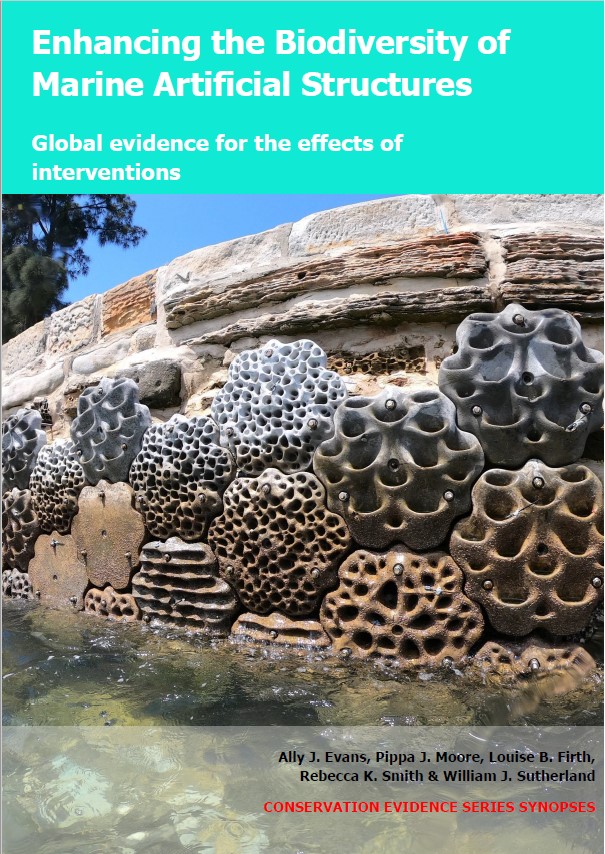Background information and definitions
Definition: ‘Reducing the slope’ includes actions taken to reduce the inclination of structures without increasing the footprint, with the aim of enhancing their biodiversity.
The slope of substrate surfaces can influence the species that colonize in subtidal rocky habitats (Harmelin-Vivien et al. 1995; Schroeter et al. 2015; but see Glasby 2000). Artificial structures tend to have steeper slopes than natural reefs, with narrower bands of subtidal habitat. This means that space for organisms is scarce and competitive interactions and other environmental processes differ (Chapman & Underwood 2011). Steep surfaces can also be associated with the presence of non-native species (Dafforn 2017).
Although fundamental aspects of structure designs, such as their slope, are likely to be driven by engineering and cost requirements, there may be opportunities to reduce the slope of subtidal artificial structure surfaces with the aim of enhancing their biodiversity. This may, however, lead to an increase in the physical footprint of structures and associated impacts on the receiving environment (Perkins et al. 2015). For this reason, studies that test the effects of creating additional artificial habitat in front of existing structures to create horizontal or gently sloping surfaces are not included in this synopsis, although such actions can deliver biodiversity benefits and are informative (e.g. Liversage & Chapman 2018; Toft et al. 2013).
There is a body of literature investigating the effects of slope on artificial reefs (e.g. Schroeter et al. 2015; Terawaki et al. 2003). These studies are not included in this synopsis, which focusses on in situ conservation actions to enhance the biodiversity of structures that are engineered to fulfil a primary function other than providing artificial habitats.
See also: Create small protrusions (1–50 mm) on subtidal artificial structures; Create large protrusions (>50 mm) on subtidal artificial structures; Create small ridges or ledges (1–50 mm) on subtidal artificial structures; Create large ridges or ledges (>50 mm) on subtidal artificial structures.
Chapman M.G. & Underwood A.J. (2011) Evaluation of ecological engineering of “armoured” shorelines to improve their value as habitat. Journal of Experimental Marine Biology and Ecology, 400, 302–313.
Dafforn K.A. (2017) Eco-engineering and management strategies for marine infrastructures to reduce establishment and dispersal of non-indigenous species. Management of Biological Invasions, 8, 153–161.
Glasby T.M. (2000) Surface composition and orientation interact to affect subtidal epibiota. Journal of Experimental Marine Biology and Ecology, 248, 177–190.
Harmelin-Vivien M.L., Harmelin J.G. & Leboulleux V. (1995) Microhabitat requirements for settlement of juvenile sparid fishes on Mediterranean rocky shores. Hydrobiologia, 300, 309–320.
Liversage K. & Chapman M.G. (2018) Coastal ecological engineering and habitat restoration: incorporating biologically diverse boulder habitat. Marine Ecology Progress Series, 593, 173–185.
Perkins M.J., Ng T.P.T., Dudgeon D., Bonebrake T.C. & Leung K.M.Y. (2015) Conserving intertidal habitats: what is the potential of ecological engineering to mitigate impacts of coastal structures? Estuarine, Coastal and Shelf Science, 167, 504–515.
Schroeter S.C., Reed D.C. & Raimondi P.T. (2015) Effects of reef physical structure on development of benthic reef community: a large-scale artificial reef experiment. Marine Ecology Progress Series, 540, 43–55.
Terawaki T., Yoshikawa K., Yoshida G., Uchimura M. & Iseki K. (2003) Ecology and restoration techniques for Sargassum beds in the Seto Inland Sea, Japan. Marine Pollution Bulletin, 47, 1–6.
Toft J.D., Ogston A.S., Heerhartz S.M., Cordell J.R. & Flemer E.E. (2013) Ecological response and physical stability of habitat enhancements along an urban armored shoreline. Ecological Engineering, 57, 97–108.






)_2023.JPG)














